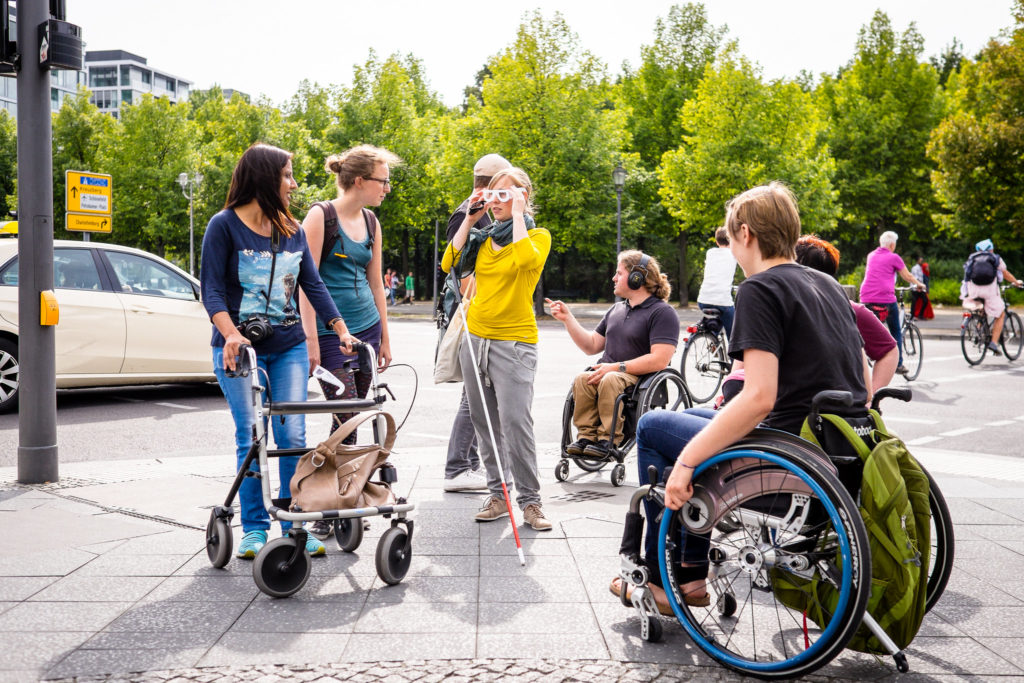ACCESSIBILITY VALUES
THE ROLE OF DISABILITY RIGHTS MOVEMENTS, POLICY REGULATIONS AND SMART DEVICES IN DESIGNING URBAN DEMOCRACY IN EUROPE

Building on my previous research project (2012-2014) I am currently developing ethnographic research on inclusive urbanism struggles and the creation, implementation, maintenance and supervision of sidewalk democracy projects in Europe, with a focus on Barcelona and Spain.
I am focusing on the different knowledges being there mobilised–such as the different registers of value, the sensory practices of urban appreciation, and the articulation of bodily diverse experience–, traceable because of their particular ‘documentation interfaces’ (the different relational and more or less institutional or activist design situations of valuation: to frame, elicit or provoke into existence and discuss diverse bodily experiences and environmental/material affordances).
For this, not only I am following different legal developments, interviewing and doing fieldwork on diverse experiences, but I have also signed a collaboration agreement with Barcelona City Hall’s IMPD (Municipal Institute of People with Disabilities) where I have undertaken fieldwork and archival work at the institute, as well as conducted interviews with different professionals and experts managing the implementation and supervision of accessibility arrangements (sidewalks and transportation) in the city.
RATIONALE: ACCESSIBILITY VALUES
In the past decades ‘urban accessibility’ has become a very important matter of concern in Europe, due to: citizenship struggles of different advocacy groups of people with disabilities or older people; and growing concern on the part of the policymaking institutions at European, state, regional and municipal levels over population ageing and the everyday higher prevalence of chronic illnesses. In fact, in the whole EU different regulatory bodies have started to promote different accessibility policies –such as building standards and specific sidewalk intervention norms– as a way to encourage social justice and equity values through the intervention of public space design.
These endeavours are introducing new and very interesting socio-technical dynamics. Indeed, accessibility measures and values are creating new markets of urban infrastructures: new building standards (norms, handbooks, building procedures, etc.) and technological devices intervening in the urban space (such as in the increasingly important development of ‘smart’ urban accessibility solutions), requiring new forms of expertise so as to manage complex design and political regulations.
This project seeks to understand the epistemic, political and economic transformations accessibility measures are entailing, building on STS warnings over the democratic deficit produced by expert divides and the subsequent concern towards enhancing citizen participation in technoscientific issues. This is done through mapping, analysing and comparing ethnographically the ‘valuation practices’ of different actors involved in urban accessibility issues in Europe (notably, Disability rights activists and technical experts such as architects and engineers). Special effort will be put to understand the problematisations and versions of ‘what count as accessible public spaces.’
I seek to bring some light into the current dynamics of expertisation, as well as the socio-economic and epistemic transformations these developments and entailing. However, in close vicinity with different initiatives developing devices for the valuation, sidewalk redesign and sensitisation, the main aim of this project is to find ways of intervening in these issues, as well as to explore different participatory registers of technical democracy, hopefully allowing the invention of further modes of relating to urban bodily diversity and the particular material affordances to host it.
ISSUES AND RELEVANT CASES
(A) POLICY PROBLEMATISATIONS AROUND ACCESSIBILITY
Focusing on the different problematisations and versions of urban accessibility (both legal-political work and activist campaigns) enacted in the different policy instruments, both at a European level and at state, regional and municipal levels.
RELEVANT CASES
- Attempts at creating a European framework for urban accessibility: European Commission’s project of the European Accessibility Act
- Statewide projects and their different approaches to the standardisation, implementation, and regulation of maintenance: Germany’s DIN 18040 & DIN 32984 | France’s Loi 2005-102
- Disputes or discrepancies between local, regional and state regulatory bodies: Barcelona’s norms and standards, and their transformation according to the development of the 2014 Catalan Law of Urban Accessibility & the recent 561/VIV Spanish state regulations
- Ongoing and organized political campaigns having urban accessibility issues at their core: Carrers per a tothom actions to regulate ‘shared streets’ and their problems for blind and partially sighted people (Barcelona, Spain) | ECOM‘s struggle for the open-access of accessibility norms and regulations (Catalonia, Spain) | European Blind Union actions to regulate silent electric cars (Paris, France & EU) | Association des Paralysées de France actions to assess and to enforce the full implementation of urban accessibility regulations in the country (Paris & Midi-Pyrénées, France).
(B) DEVICES FOR THE VALUATION AND SENSITISATION OF IN/ACCESSIBILITY
Having an understanding of the different devices for the valuation of urban in/accessibility, as well as for the sensitisation of technicians and citizens alike.
RELEVANT CASES
- Smartphone in/accessibility mapping apps: Megafone.net & App&Town (Spain) | J’Accede (France) | Wheelmap (Germany) | BlindMaps (Austria)
- Mediating artefacts for the communication of architectural design needs, or the sensitization of technicians to multi-sensory requirements: BBSB (Munich, Germany) | Modellbaukasten: Taktiles und visuelles Blindenleitsystem im öffentlichen Verkehrsraum (Germany) | Tracktile (Germany)
(C) URBAN INTERVENTIONS: SIDEWALK DESIGN
Paying attention to urban accessibility initiatives (both institutional and advocacy groups) developing urban interventions involving the redesign of sidewalks or their elements.
RELEVANT CASES
- The daily work of architects and urban planners (e.g. reporting, construction field-site supervision, etc.,) as well as other professionals involved in municipalities dealing with urban accessibility: Municipal Institute of People with Disabilities (Barcelona, Spain)
- Developments of new pedestrianisation plans, involving new sidewalk designs (in dispute with previous modes of construction) for urban accessibility: Plano de Accessibilidade Pedonal de Lisboa (Portugal)
- Responsive and/or multi-sensory approaches to accessible sidewalk design: Ross Atkin Associates (UK) | Open Network Beacons Barcelona (Spain)